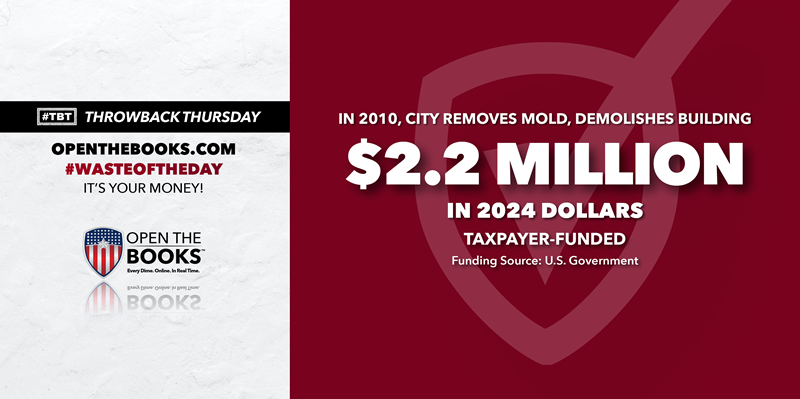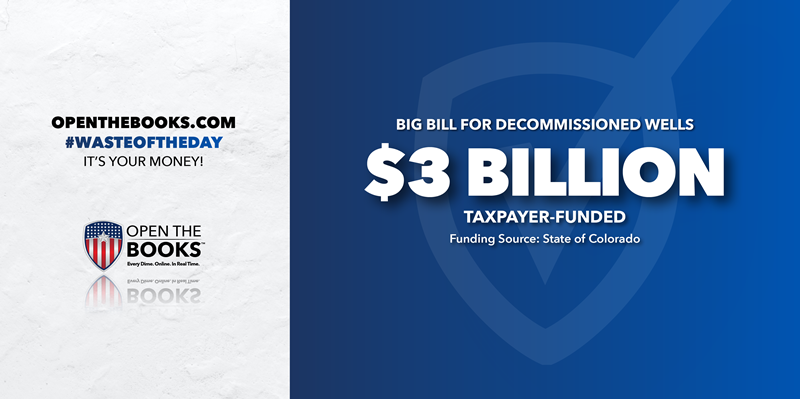
Santa Clara Will Spend $213 Million on Rail Cars – They Won’t Use Until 2037!
August 12, 2024

Topline: This May, the County of Santa Clara, California agreed to spend almost $213 million on 48 new rail cars. There’s just one problem: Santa Clara has yet to build its new railway.
Instead, the rail cars will service nearby counties until Santa Clara opens its Bay Area Rapid Transit System (BART) station in 2037, at which point the cars will be a quarter of the way through their lifetime.
This is the true definition of putting the cart before the horse.
Key facts: Santa Clara’s new rail station was supposed to be completed by 2026 at a cost of $4.4 billion, but delays have pushed the project back 11 years and added over $8 billion to the price tag.
But the county already had an agreement with BART in place to buy new rail cars in 2026 at a discounted rate. If they don’t buy them now, the discount will expire and the cars could cost more than $450 million, county official Tom Maguire told The Mercury News.
Santa Clara can’t just keep the cars in storage until 2037 either. Maguire says that would degrade them faster than if they’re being used.
The only option is to let BART use the rail cars in other California cities until the Santa Clara station opens. The county voted to do just that, shelling out $172.6 million for the cars and agreeing to pay $4 million per year for maintenance over the next decade.
Search all federal, state and local government salaries and vendor spending with the AI search bot, Benjamin, at OpenTheBooks.com.
Critical quote: “If I have a child and they’ll turn 16 and start driving, I’m not going to buy a car for them when they’re born so that by the time they’re 16 that car will be worth a lot more,” County Supervisor Otto Lee told The Mercury News. Lee voted against the rail car purchase.
Background: Rather than cut costs, the federal government has decided to support to the final phase of the Silicon Valley BART Extension project with a $5 billion grant. County officials say it’s the second-largest federal investment in any transportation project in U.S. history.
Santa Clara is one of several counties around the U.S. wasting taxpayer money on delayed transportation extensions. U.S. Senator Joni Ernst calls these projects, “billion-dollar boondoggles.”
Construction on the Red Line light rail system in Baltimore has been paused and restarted by several governors since 2008. It will now cost up to $4.3 billion more than it would have without the delays.
The Southwest Light Rail Transit Project in Minnesota was supposed to open last year at a cost of $2 billion. New estimates say it will open in 2027 for $2.85 billion.
Summary: Taxpayers deserve transportation systems that are completed quickly and stay under budget. When projects get mired down by technicalities and rising costs, everyone loses.
IRS Employees Owe $50 Million In Unpaid Taxes
August 13, 2024

Topline: Nearly 6,000 Internal Revenue Service employees and contractors owe $50 million in overdue taxes, according to a federal audit published in July.
Key facts: The tax-dodging employees represent 5% of the IRS workforce. Roughly two-thirds of them still do not have a plan in place to pay their taxes properly.
Federal law requires the IRS to fire workers who intentionally don’t pay their taxes, but auditors said, “this disciplinary action is not always enforced.”
The IRS disciplined 1,068 employees between October 2021 and April 2023 — including 139 who “willfully” paid their taxes incorrectly — but only 20 of them were fired. Others had their cases “mitigated” because they had been working for the IRS for a long time or had high job performance ratings.
Seventy-six employees were suspended, mostly for two weeks or less.
Auditors also found that the IRS rehired 397 employees and 115 contractors who previously had conduct issues, including 282 workers with more than one conduct or performance issue. The “conduct issues” ranged from unauthorized access to taxpayer returns to sexual assault and criminal behaviors. Eighty-five of them previously had issues paying their taxes, and 306 had “unacceptable” job performance.
Background: A previous audit found that the federal government as a whole had 149,000 employees with $1.5 billion in unpaid taxes in 2021.
Meanwhile, everyday citizens continue to fund the IRS’ $4.9 billion payroll. The agency paid six-figure salaries to 11,846 people in 2022, according to payroll records at OpenTheBooks.com.
That includes employees supposedly hired to help taxpayers. The IRS’ “taxpayer experience officer” makes $200,000, and the “national taxpayer advocate” makes $203,000.
Search all federal, state and local government salaries and vendor spending with the AI search bot, Benjamin, at OpenTheBooks.com.
Critical quote: “Thank you for committing to ‘trying to rebuild trust’ in the IRS by holding the agency ‘accountable to taxpayers,’” Sen. Joni Ernst (R-IA) wrote in a letter to IRS Commissioner Daniel Werfel. “Today is a great day to demonstrate the seriousness of that pledge by making the thousands of tax-evading tax collectors at the IRS either pay up or pack up. Taxpayers will never trust the IRS when the agency’s own auditors can’t even pass a tax audit.”
Sen. Ernst spearheaded the Congressional measure mandating the audit and leading to these disclosures.
Summary: It’s crazy to think that nearly 6,000 employees working for the tax collection agency – whose salaries are paid by hard working taxpayers – are tax cheats!
Dwayne Johnson’s $11 Million Army Marketing Deal Hit Rock Bottom
August 14, 2024

Topline: The Rock has layeth the smackdown on the U.S. Army’s budget.
The Pentagon’s $11 million marketing deal with pro wrestler and actor Dwayne Johnson likely didn’t cause a single person to enlist in the Army, according to internal documents obtained by Military.com.
The Army estimates that it actually lost 38 enlistments by not using its time and money on other recruiting tactics.
Key facts: The deal included $5 million for Johnson to make five social media posts promoting the military to his 396 million Instagram followers, but Johnson only posted twice.
The Army logo was also displayed on players’ jerseys during the debut season of the United Football League earlier this year — the upstart minor league alternative to the NFL. But the league, which Johnson co-owns, had viewership that “was too low, and even the most optimistic estimation showed the partnership would not yield many recruits,” according to Military.com.
Marketing officials warned of the financial risk, but Army Chief of Staff Randy George pushed for the deal directly, according to emails.
Another internal document claims the Army picked up a “significant amount of additional work” because of the UFL’s “lack of experience” with marketing deals.
The Army is asking Johnson to return $6 million, though Military.com says it’s unclear how that number was determined.
Background: Waste is not uncommon at the Pentagon’s lethargic bureaucracy.
Only 21% of the Department of Defense’s 2025 budget request will go to “Active Forces.” Far more will go toward “operations & maintenance” such as marketing.
Other questionable marketing campaigns have included the $4.3 million the Navy spent last year on advertising through online video games, including paying officers to play Fortnite.
Search all federal, state and local government salaries and vendor spending with the AI search bot, Benjamin, at OpenTheBooks.com.
Critical quote: “While the Army may have thought they were getting The Rock, they were instead primarily getting a partnership with a minor football league,” former Pentagon communications advisor Megan Sweeney told Fortune. “The Rock is an investor of the UFL, but it’s not like he’s on the sidelines of every game. As a result, the Army seems to have paid Hollywood-level sponsorship money for minor-league exposure.”
Summary: If Johnson’s long-rumored presidential bid ever becomes a reality, he’ll need to learn more about helping the government get value out of its contracts.
Throwback Thursday: City Cleaned Up Building Before Demolition
August 15, 2024

Throwback Thursday!
Topline: In 2010, a city in Louisiana made plans to demolish a crumbling housing development and then spent $1.5 million to remove mold and mildew from the building.
That’s according to the “Wastebook” reporting published by the late U.S. Senator Dr. Tom Coburn. For years, these reports shined a white-hot spotlight on federal frauds and taxpayer abuses.
Coburn, the legendary U.S. Senator from Oklahoma, earned the nickname "Dr. No" by stopping thousands of pork-barrel projects using the Senate rules. Projects that he couldn't stop, Coburn included in his oversight reports.
Coburn's Wastebook 2010 included 100 examples of outrageous spending worth more than $11.5 billion, including the money spent on mold remediation — which would be worth $2.2 million today.
Key facts: The City of Shreveport got a stimulus check from the federal government by promising to renovate its affordable housing. It received $1.7 million but only planned to use $100,000 of it to remove mold and mildew in a complex called Wilkinson Terrace.
Ten months later, Shreveport had barely spent any of its funds. Federal officials reminded the city that the funds must be returned if they weren’t spent by the end of the year.
The city scrambled to use the money before the deadline, awarding $1.5 million to remove the mold at Wilkinson Terrace.
That still wasn’t enough for workers to do a proper cleanup job. Federal auditors later found “pest excrement caked on surfaces that were to have been cleaned and disinfected.”
Renovating Wilkinson Terrace made almost no sense. The building, a hot spot for gang and drug violence in the 1980s, was already being considered for demolition. It closed in 2019 and was torn down in 2021.
Federal auditors recommended that the government take back its stimulus funds, saying “The Authority mismanaged its Recovery Act funds by entering into imprudent contracts to meet the March 17, 2010 obligation deadline.”
Search all federal, state and local government salaries and vendor spending with the AI search bot, Benjamin, at OpenTheBooks.com.
Summary: Wilkinson Terrace is a textbook example of the “use it or lose it” spending that occurs at all levels of government. Many officials would rather use appropriated funds on wasteful purchases than admit their budget is too high.
Coloradans Could Pay $3 Billion for Oil Companies’ Mess
August 16, 2024

Topline: Colorado’s oil and gas wells are not profitable enough to cover their own cleanup costs.
A new study from the Carbon Tracker Initiative says low-producing, aging “legacy” wells will only generate another $1 billion in revenue before they must be decommissioned at a cost of $4 billion to $5 billion. That leaves a gap of at least $3 billion that taxpayers will likely be responsible for.
Key facts: The study analyzed Colorado’s more than 27,000 legacy oil and gas wells which represent 57% of all wells in the state. When active wells are included, the cleanup cost rises to up to $8.5 billion, but many of those wells are profitable before they're shut down, so taxpayers funds might not be used.
A single well can cost over $110,000 to “plug,” according to The Guardian. If it's not done properly, the well can leak carcinogens and methane. When oil companies don’t have enough money to do it themselves, the responsibility falls to the state.
Colorado passed laws in 2019 that were supposed to make sure energy companies had enough cash to decommission their own wells. But the Carbon Tracker Initiative says the rules are filled with loopholes and will only save taxpayers $654 million by 2029 in the “best-case scenario.”
The state has also struggled to enforce its law. It ordered drilling company K.P. Kauffman to save $133 million over the next 10 years for well decommissions, but the company has already said it can’t pay a $2 million fine levied by the state, according to The Guardian.
Sixty-six energy companies haven’t submitted plans to cover the cost of cleaning up their unplugged wells, but so far they’ve only been “sent some enforcement letters,” The Guardian reported.
Search all federal, state and local government salaries and vendor spending with the AI search bot, Benjamin, at OpenTheBooks.com.
Background: As of 2022, there were at least 120,000 “orphan wells” in the U.S with no owners to be found. Some estimates say there could be another 1 million waiting to be discovered, according to The Washington Post.
President Biden’s Bipartisan Infrastructure Law allocated $4.7 billion to help states clean them up.
Summary: Most Americans are taught as early as kindergarten to pick up after themselves. Someone needs to remind oil companies of basic etiquette.
The #WasteOfTheDay is presented by the forensic auditors at OpenTheBooks.com.